I started this beautiful day here
where I bought some flowers for Gail
and peaches and cream corn for myself.
Then it was out to
Taken from their website!!
The Three Lives of Myra Canyon

Building the Kettle Valley Railway
The turn of the 20th century was the time of a mining boom in the east and west Kootenays. Gold and silver were the prime lures but there was also lead, zinc and copper. And there was a flurry of prospecting activities and the development of some fantastic mines.
It was also a period of almost frantic railway building. The CPR mainline was completed in 1885 but the line was too far north to service the boundary country. They very quickly began their Crow’s Nest Pass line that eventually brought them to Midway in the west Kootenay country.
The Great Northern Railroad was also completed – the northernmost of the American transcontinental lines. The GN was able to build secondary lines up the north-south valleys with comparative ease, to tap the mineral resources to their smelters in the States and to ship the products to tidewater, drawing off what the CPR saw as their own traffic.
There was another major factor at work -- “Manifest Destiny” was alive and well in the U.S., and there was a well-established annexation movement with members and advocates on both sides of the border. And the Americans saw it as a cruel trick of nature and of boundary making that all these riches should be just across the border in Canada.
This was the situation that finally moved the CPR directors, and in particular, president Thomas Shaughnessy to complete their southern provincial route and to connect the Kootenay resources to the ports of Vancouver and New Westminster. They did it through the Kettle River Valley Railway which then existed but had no track.
In 1910, they started building from Midway, west and shortly after, from Penticton in both directions. The engineers and Chief Engineer Andrew McCulloch, had two daunting challenges. One was building through the Coquihalla Canyon near the town of Hope to get an acceptable grade – maximum of 2.2 % -- up to Coquihalla Pass. The other was getting over the Okanagan Highlands which separated the West Kootenays from the Okanagan Valley – again with a maximum grade of 2.2%.
McCulloch solved the first with the Quintette tunnels – a fabulous engineering achievement, and the second with a series of long switchbacks east of Penticton, up to Chute Lake Pass, and the Myra Canyon trestles.
Myra Canyon is a deep, steep and wide canyon, carrying two main creeks – east and west Canyon Creeks. He hung his railway on the sides of this canyon, taking some seven miles of track to reach across something less than one mile. It took 20 wooden trestles of various lengths and heights to do it. (One was later filled in and one was by-passed). It is at 4100 feet elevation – 3000 feet above Kelowna and the highest section on the whole KVR.
The Myra Canyon section was completed in 1914. McCulloch himself said that he had never seen a railway built in such difficult conditions anywhere in North America and possibly in the world.
The Coquihalla section was opened in 1916 and the southern route to the coast was complete. A branch line from Brookmere to Merritt hooked up with the line from the mainline at Spence's Bridge to Merritt.
The KVR was the major element in the economic development of the southern interior for the next 65 to 70 years.
For a detailed history of the construction of the Myra Canyon section of the Kettle Valley Railway, see “Myra’s Men – Building the Kettle Valley Railway – Myra Canyon to Penticton” by Maurice Williams.

II Creating the Myra Canyon hiking and cycling trail
The Carmi section of the KVR – Midway to Penticton – carried its last train in 1972 and the rails came up in 1980 after the provincial government had acquired the right-of-way. There were some attempts to keep the rails and use the line for tourism, but those failed and the trail and the trestles fell into disrepair from vandalism and neglect. People were using the trail in spite of the difficulty of access and several serious accidents occurred. The government contemplated closing the site to the public.
Then in 1992, the Myra Canyon Trestle Restoration Society (MCTRS) was formed with the object of restoring the trestles to make them safer for the public.
This was a totally volunteer effort and over the next three seasons, each of the trestles was decked with a four-foot boardwalk and equipped with guard rails. Community groups and individuals came forward to sponsor a trestle with volunteer labour or funds, or both. All the labour, materials and equipment were either donated or purchased with donated funds.
When that first work was completed in 1995, the Society turned its attention to repairing the trail, a major tunnel portal project, and rock scaling in the tunnels and rock cuts.
Visitor numbers began to increase remarkably and it was found that pit toilets had to be provided. The Society approached BC Parks and they reluctantly provided what they called “highly experienced” toilets. Society members dug the holes, lined them with 4-foot culvert, erected the buildings and painted them up.
Then came benches that were built by the Society and installed at view points and convenient rest points. Interpretive signage followed as did electronic people counters.
The number of visitors continued to climb to 50,000 per season.
There was a lot of interest from the local media and from recreational media, virtually all over the world and Myra Canyon became a destination of its own for adventure tourism. For instance, a major cycling magazine in the US rated it as one of the 50 best bike rides in the world.
Once the project was complete, the Society undertook to maintain the trail and trestles. About this time, members saw the need to protect the site and the best way to do it was to have it declared a provincial park. There was some interest in official circles but the Okanagan Shuswap Land and Resource Planning table for crown lands was just being formed at the time and the policy was that any new parks would come out of that process. It was to take 2 years, so MCTRS became part of the planning process for the valley. It actually took 5 years, but in the end Myra Canyon became part of the new Myra-Bellevue provincial park.
The next step was to have the history of the Kettle Valley Railway and of Myra Canyon in particular, recognized. So the Society applied to the National Historic Sites and Monuments Board for designation of Myra Canyon as a place of national historic significance. That designation came to pass in January, 2003, just months before the Okanagan Park forest fires destroyed 12 of the trestles.
III The Disastrous Fires of 2003 and the Reconstruction of the Trestles
2003 was probably the 5th year of drought in the Okanagan Valley and many forest fires took place. In mid-August a lightning strike in Okanagan Mountain Park started a fire that for nearly a month, would burn and spread for many miles from its source. Despite a huge firefighting effort, the fire consumed more than 200 homes in Kelowna, and over 20,000 acres of forest and parkland. In the first week of September, it reached the Myra Canyon trestles and in the next few days, destroyed 12 of the 16 wooden structures and damaged the two steel bridges. In addition there was damage to the trail itself, to the rock faces and to the amenities which had been built up over the previous ten years.
In the aftermath, a steering committee was formed of various stakeholders to assess the damage and estimate the costs of replacement. Then the Premier of B.C. appointed a Task Force to receive advice from the steering committee and to make recommendations to the Premier’s office regarding the question of abandoning the site or rebuilding the trestles and if the latter, to recommend potential strategies for funding the costs. The Task Force members were MLA Rick Thorpe, representing the province, Senator Ross Fitzpatrick, representing the federal government, Kelowna Mayor Walter Gray and Ken Campbell, past president of MCTRS (Myra Canyon Trestle Restoration Society).
Abandonment was scarcely considered and the Task Force recommended that the trestles be rebuilt and that they be designed to resemble the original structures both for historic reasons and to showcase the versatility and dependability of B.C. forest products.
The heritage values of the trestles as recognized by the Historic Sites and Monuments Board, were a key to the decision to replace the trestles. In addition there were the recreation and tourism values and arguably the most important consideration was the total involvement of the community in the original restoration.
A number of funding options were considered including a major telethon, but in the end, it was found that the reconstruction costs would be eligible for the Federal/Provincial Disaster Relief Fund. This is a standing agreement between the two senior levels of government in which the eligible costs are shared 90% from the federal government and 10% from the province.
The rebuilding was placed in the hands of the Myra Canyon Reconstruction Project Management Committee comprising members of the MCTRS and BC Parks.
In deciding to rebuild the trestles to resemble as closely as possible the ones which were lost, the design would be to lower strength standards. Not needing to carry trains, they were designed to carry heavy construction equipment that would have to cross the trestles to access all the construction sites. They would have fewer horizontal stringers and fewer vertical legs in the bents, and in some cases, fewer bents, but would still be over-built for their intended use once they were finished.
Before work could begin, a great deal of rock stabilization work was necessary to repair the damage from the heat of the fire and to protect the safety of the workers who would be doing the reconstruction. This alone was a substantial cost factor.
The first trestle, #18, was rebuilt in the fall of 2004, just one year after the fire. Five more were completed in 2005, four in 2006, three in 2007 and the final one in early 2008.
The bridge building community in British Columbia was very interested in the project and they brought their old skills and new techniques to it with high quality work and cost effectiveness.
The government funding was restricted to replacing the trestles themselves and collateral damage directly related to the fire. Other improvement projects are being provided by MCTRS volunteers with donated funds. These include resurfacing of the trail, installing interpretive signage and repairs when they are needed. MCTRS has entered an agreement with BC Parks to maintain the trail and the trestles from the ties up. Thus the all-important community involvement with the Myra Canyon trail continues.
With the trail and trestles reopened, a crucial link in the TransCanada Trail and the Spirit of 2010 Trail has been restored.
So this was to be my days adventure…I drove Ramona to the parking lot at the start of the 24km round trip and my escort for today was Miranda…she is the third cousin of Ramona, once removed on her mother’s first husband’s side…Got it good?? here is Miranda.
On the first bridge..
The bridges and scenery were quite amazing so join me on the ride…
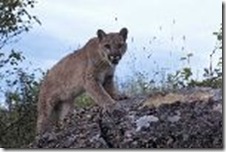 if you can picture this cougar crossing the path in the photo below
if you can picture this cougar crossing the path in the photo below
that is what I saw he passed very quickly from one side to the other about 30 feet in front of me…my very first cougar sighting!!!
I had lunch on one of the bridges and it was a great adventure and one I recommend to anyone in this area.
This evening Gail, Larry and I went here for supper
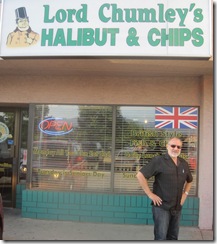 it has become a tradition with us.
it has become a tradition with us.
I had a lovely day and just want to close by hoping Sara is enjoying her kayak trip and there is still no change in Ken’s condition and I send my best wishes out to him!!

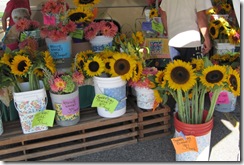
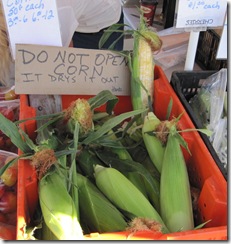
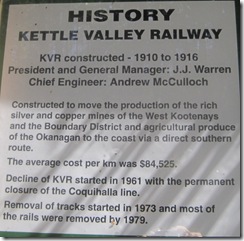

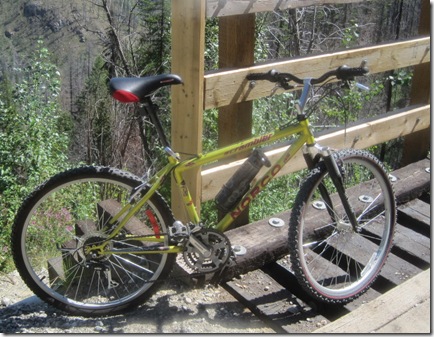
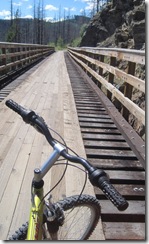
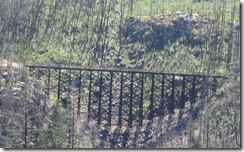
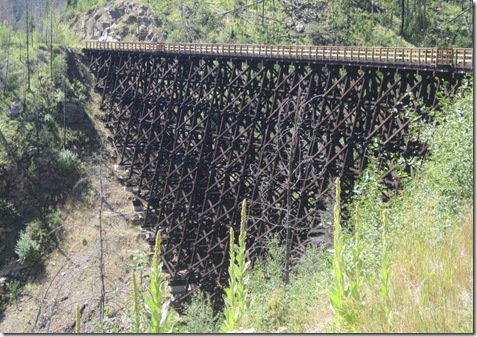
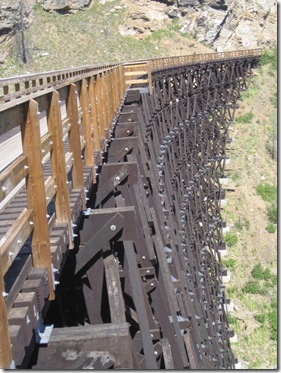
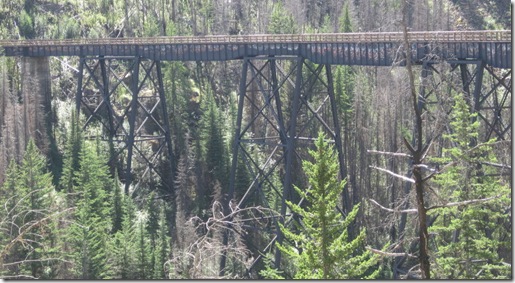
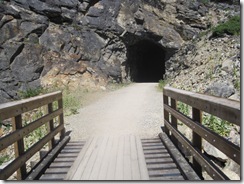

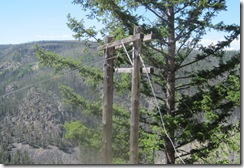
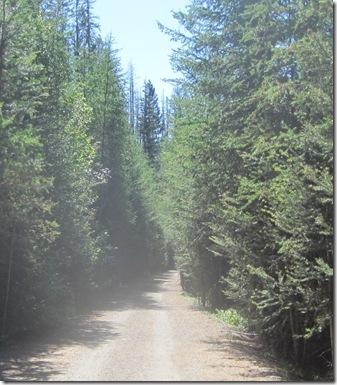

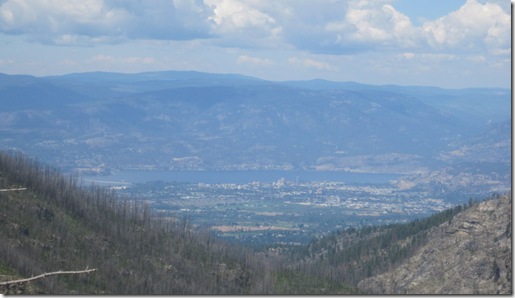
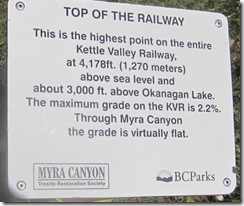


No comments:
Post a Comment